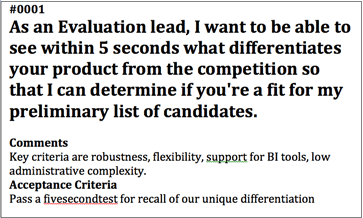
How are development user stories and agile marketing user stories different? How do marketers implement user stories in their workflow? Let’s take a look at these issues.
Development vs Marketing User Stories
Here is a table of some of the differences between user stories used for development, compared to those used for Agile marketing:
Development User Stories | Marketing User Stories |
| Low level | High level |
| Lots of them | Relatively few |
| Left brain | Right brain |
| Focus on functionality | Focus on outcomes |
Because development user stories focus on relatively low level details and functionality, there tend to be lots of them in any given project: at least 20-30, and sometimes hundreds. Agile marketing user stories are higher level, and typically, there are fewer of them: generally under 10 per persona, and often only 3-4 per persona.
Development user stories tend to focus on left-brain-oriented processes and functionality, “I want to login so that I can access subscriber content”. Marketing user stories tend to focus on right-brain outcomes that have emotions associated with them. “As a mom, I want to take and share videos of the kids so that I can share important moments with grandparents, aunts, uncles and friends.”
As marketers, we sometimes focus too much on function/feature rather than outcomes. Good marketers and salespeople have learned this lesson. How does the Nordstrom saleslady sell a dress? Not based on features/functions (it has spaghetti straps, a street-length hem and six buttons), but based on outcomes (You look great in that dress. Your husband is going to love it).
The back of the card containing a development user story outlines the test cases for the implementation of the user story. When documenting marketing user stories, I use the back of the card for a different purpose. In one column, I list the SEO keywords associated with the user story. This reminds me, if I’m generating a piece of content to address the user story, of the keywords and phrases that I need to incorporate in to my text.
In the second column, I list the alternatives that the user has to address this user story, starting with how they address it at present. This column represents the competition, but it’s important to list more than just formal competitors (other companies in your market). How does the user achieve the outcome at present? In the example above, perhaps the mom uses a traditional camcorder to record videos of the kids, or perhaps she doesn’t record video at all, but uses a digital camera and shares stills.
So how to get started using Agile Marketing user stories? Begin by documenting the personas relevant to your product or service. I use a template to describe my persona. After I document my personas, I begin writing down user stories for each one of my personas.
At times, there is overlap – multiple personas want the same outcomes. But often, different personas in a market or a sales cycle want different outcomes. By documenting these user stories as a team, including the SEO keywords and the alternative solutions, we can be more consistent and more effective.

